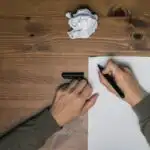Learning while homeschooling should mean more than simply getting a grasp of academic skills.
There is a world apart from the dedicated learning environment you may have developed in the home.

As a parent, you should be keen on allowing your homeschooling child some time off, especially during summer when the sun is out.
That should mean some outdoor water fun at home, and it can even prove educational.
There are many different ways you can have some outdoor water fun – from water balloons to water shooters, water walls, water wheels, and even getting your car washed.
Read on to find out which ideas you want to introduce.
1. Water Wall
Creating a water wall can both be fun and educational; you only need a few simple materials.
While your homeschooled child may believe they are being involved in a fun water-based activity, this can be considered a STEM project.
That’s right, building a water wall encompasses the subjects of science, technology, engineering, and mathematics.
It helps if you have a fence already up in your garden, yet you can always use an upturned wood pallet or deck railings as the basis for your wall.
Head to the store and grab some plastic PVC tubing, a deconstructed rain gutter, zip ties, PVC pipes and joints, funnels, pool noodle pieces, plastic recycled containers, and shovels.
Use the zip ties to attach the detachable pieces to the fence, wood pallet, or deck railings. Those will include:
- The plastic PVC tubing
- Rain gutter pieces
- PVC pipes and joints; and
- Pool noodle pieces.
Construct it in such a way that the water will flow from the top to the bottom.
From a funnel into a piece of rain gutter at the top into a pool noodle piece, then a shovel via some PVC pipes and joints.
You can capture all the water in some plastic containers at the bottom; you could even have a water wheel as an extra exciting touch.
Finally, use a garden hose to pour the water into the wall at the top.
Watching the flow of water can prove to be an educational experience for any homeschooled child.
Let them take control by moving some of the detachable pieces and creating their own route.
As the water moves, you can demonstrate how gravity works and how kinetic energy is produced.
2. Water Wheel
Watching the flow of water does not have to involve advanced engineering, as the water wall demonstrates.
To create your water wheel, find some:
- Sticky, ideally waterproof, tape (such as duct tape)
- A wooden skewer
- Around six paper or plastic cups; and
- Two paper or plastic plates.
The water wheel, also considered a homemade water mill, can prove to be a lesson in engineering and history.
It can be a good example of engineering as it demonstrates how the flow of water can generate energy, and it can demonstrate history as the wheel shows how the process was used to grind flour many years ago.
Grab your wooden skewer and poke a single hole through the middle of each plate. You’ll need to turn one paper plate so that its bottom is facing up to affix the cups.
Depending on the sizes, you should be able to tape the cups onto the bottom of the plate with the cups facing outward.
Make sure they are securely fastened, and sandwich the cups with the second plate by pushing the skewer through the plates and using more tape.
Your construction should look like a crude water mill with the cups as buckets, so all you need now is some water.
Head outside to a tap or carefully use your garden hose to pour on some water.
Hold the skewer at both ends, slowly fill up each cup, and gradually watch the water wheel spin.
As the wheel moves, you can show how the flow of water creates kinetic energy from gravity and the water’s own weight in a makeshift engineering lesson.
3. Water Balloon Jousting
If you want to get some good use out of the pool noodles you may have used on the water wall, you can reuse them for some Water Balloon Jousting.
You only need a few more household items, including:
- Heavy-duty string,
- A plastic fork,
- A marker pen,
- A cutting knife; and
- Some more duct tape.
If your homeschooled child enjoys swimming, then they should have a spare foam kickboard, which you can use, too.
Fill up around 30 to 40 water balloons and tie each end securely with the string. Use the marker pen to sketch out a large circle on the foam kickboard, then carefully cut it out with the cutting knife.
Add some dots to the circle at points where you can cut holes for the water balloons to be inserted via the tied ends.
Typically, you should have five or six balloons going across the center of the circle with room for fewer balloons at the top and bottom.
Tape the balloons down with duct tape to make sure that they are securely fastened.
Once you have the balloons in place, cut out two lengths of the string and fix one to the slit in the top right corner holding the uppermost row of balloons.
The other length of the string will go to the top left, so you can tie the kickboard to anything you can hang it from, ideally a tree branch in your garden.
With your foam noodle, attach the plastic fork at the end with some duct tape. This will form your joust, and you can take turns jabbing at the kickboard and bursting some balloons to watch the water stream out.
4. Water Shooter
Another fun outdoor water-based project that can demonstrate the principles of engineering is making your own water shooter.
Start with a two-foot long piece of PVC piping that has a 1.5-inch diameter and another piece of piping that’s equally as long but a little bit smaller in diameter, measuring three-quarters of an inch for your inside pipe.
You can also use another pool noodle, some more duct tape, and a cutting knife.
Other items you will need include a drill, saw, super glue, PVC cement, and a PVC cap.
Using the saw, cut out a section of the 1.5-inch diameter pipe measuring 17 inches, then glue on the cap and let it dry.
Once ready, drill out a hole in the cap, ideally with a 5/16 drill bit, to eventually create a powerful stream of water.
You will need the inside pipe to be airtight while being able to slide when it’s in the larger pipe.
To make it airtight, cover the end of this pipe with some duct tape, then cut off a piece of the pool noodle a couple of inches long.
This is the tricky part, as the inside pipe will need to fit inside the pool noodle, and both need to fit inside the larger pipe.
You may need to cut away the inside of the pool noodle so that it fits tightly around the inner pipe and still fits in the larger pipe.
When it’s slightly tight but maneuverable, that’s just about right. Make sure the pool noodle stays in place by fixing it with super glue and wrapping around some duct tape.
Place a small piece of duct tape over the drilled hole in the cap, partly fill the outer tube with water, and feed the inner pipe through the pool noodle.
As long as you have made an airtight seal when you push the inner pipe with enough force, the water should come bursting out of the duct tape, and you can shoot it out.
As long as you do not mind getting wet, these water shooters can provide so much outdoor water fun.
5. Car Washing
As your homeschooled child becomes a teenager, they can expect to get more responsibility.
What better way to introduce them to driving than letting them clean a car, your car, to be exact?
Sure, they can expect to be paid for the job, yet they can also learn about the different components of a car along the way.
Perhaps when they’re done, you can even give them a crash course in how the engine works while it gets a polish.
Final Thoughts
One of the great aspects of homeschooling is the freedom that comes with it. Rather than your child being sat in a classroom in an institutional, educational environment, you can mix up their learning.
You may still be using a blackboard, but if the weather is good, you can have some outdoor water fun.
Some of these ideas require some extra materials, yet even constructing them can demonstrate an array of engineering skills.
Try to work out which projects make more sense for the age of your homeschooled child.
Car washing is ideal for teenagers, yet a water shooter, water wall, water wheel, and water balloon jousting are aimed at a younger audience.
- Homeschooling In High School: Pros And Cons - February 24, 2024
- How Do I Withdraw My Child From School To Homeschool? - February 23, 2024
- How To Not Go Crazy Homeschooling Kids: A Guide For Frazzled Parents - February 22, 2024









Leave a comment